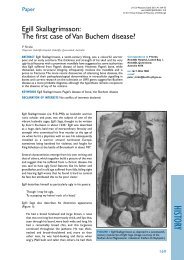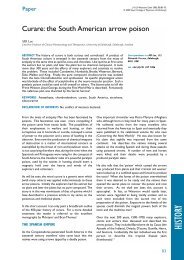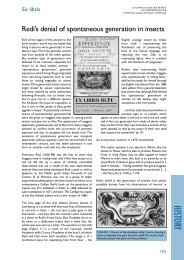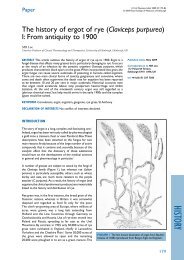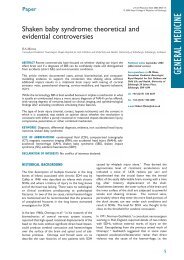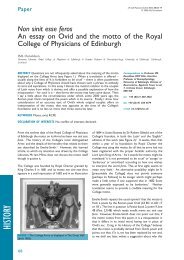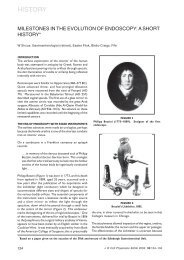The Solanaceae II: The mandrake (Mandragora officinarum); in ...
The Solanaceae II: The mandrake (Mandragora officinarum); in ...
The Solanaceae II: The mandrake (Mandragora officinarum); in ...
You also want an ePaper? Increase the reach of your titles
YUMPU automatically turns print PDFs into web optimized ePapers that Google loves.
witless that <strong>in</strong> the course of harvest<strong>in</strong>g (or handl<strong>in</strong>g) the<br />
root they would be struck down dead, or alternatively,<br />
possessed by an evil Satanic spirit that would force them<br />
to commit unspeakable s<strong>in</strong>s, condemn<strong>in</strong>g them to hellfire<br />
and damnation.<br />
<strong>The</strong>refore magic must be met by more powerful magic.<br />
First came the ritual of the Greeks who drew special<br />
circles around the plant while fac<strong>in</strong>g west to placate the<br />
Chthonic gods. <strong>The</strong>n <strong>in</strong> the Christian era came the dog.<br />
This acted as a classical scapegoat and it was hoped that<br />
the evil spirit would pass <strong>in</strong>to the unfortunate animal as<br />
the root was harvested.<br />
<strong>The</strong> dog would be fasted for several days to get it <strong>in</strong> the<br />
right state of m<strong>in</strong>d (extreme hunger)! It was then tied<br />
by strong cords to the stem of the plant. Pieces of meat<br />
were thrown just out of its reach. In its agitation to get<br />
someth<strong>in</strong>g to eat the dog would haul the dreaded plant<br />
out of the ground. <strong>The</strong> dog died (or may have been put<br />
to death) at the spot where the <strong>mandrake</strong> was<br />
unearthed. <strong>The</strong>n, with the appropriate <strong>in</strong>cantations, the<br />
evil spirit passes back from the dog <strong>in</strong>to the ground. As<br />
time went on various modifications (and amplifications)<br />
were <strong>in</strong>troduced, described by Aelian <strong>in</strong> his book De<br />
Natura Animalium.<br />
For example, it is stated that the diggers must only go out<br />
on the day of Venus (Friday). Also because the <strong>mandrake</strong><br />
may emit wild terrify<strong>in</strong>g shrieks which could send the<br />
gatherers mad they must plug their ears with pitch (or<br />
wax). A crucifix was affixed to the plant before it was<br />
disturbed <strong>in</strong> order to subdue the evil spirit.<br />
<strong>The</strong> day, the hour and the season of the year were all<br />
important to the diggers, both to ensure the efficacy of<br />
the root extracted and the safety of gatherers. <strong>The</strong> hour<br />
preferred was before sunrise because at that time the<br />
plant was said to be most active <strong>in</strong> produc<strong>in</strong>g its magical<br />
pr<strong>in</strong>ciples and the evil spirit guard<strong>in</strong>g them was likely to be<br />
asleep. Mandrake was needed both as a love potion and<br />
a means of ensur<strong>in</strong>g fertility.<br />
Certa<strong>in</strong> seasons of the year were more successful than<br />
others for the gather<strong>in</strong>g of the plant <strong>in</strong>clud<strong>in</strong>g <strong>in</strong> particular<br />
Midsummer Day (or the follow<strong>in</strong>g night). This was the day<br />
traditionally dedicated to St John the Baptist (25 June) and<br />
as Lee has po<strong>in</strong>ted out was also the preferred time for<br />
harvest<strong>in</strong>g Hypericum perforatum (St John’s Wort)<br />
another sacred plant. 9<br />
It should be made clear that many magical and medic<strong>in</strong>al<br />
plants had similar ceremonies associated with their<br />
gather<strong>in</strong>g but without the dog. Apart from St John’s<br />
Wort, they <strong>in</strong>cluded Valerian, Selago and the Peony.<br />
Common rites <strong>in</strong>cluded the recit<strong>in</strong>g of the Pater Noster,<br />
Ave Maria, the Apostles’ Creed and selected portions of<br />
St John’s Gospel.<br />
J R Coll Physicians Ed<strong>in</strong>b 2006; 36:278–285<br />
© 2006 RCPE<br />
<strong>The</strong> <strong>Solanaceae</strong> <strong>II</strong>: the <strong>mandrake</strong><br />
<strong>The</strong> historic <strong>in</strong>structions conclude with show<strong>in</strong>g due<br />
reverence to the root. First, it should be placed <strong>in</strong> a<br />
runn<strong>in</strong>g stream for a day and a night to take away the ta<strong>in</strong>t<br />
(or sta<strong>in</strong>) of the Devil. <strong>The</strong>n it should be wrapped <strong>in</strong> a<br />
clean white l<strong>in</strong>en cloth and stored with care. It should be<br />
placed <strong>in</strong> a secure wooden box and when brought out for<br />
the adm<strong>in</strong>istration of spells appropriate prayers should<br />
always be said. In some ways, the handl<strong>in</strong>g of <strong>mandrake</strong><br />
resembles the treatment of the relics of the Sa<strong>in</strong>ts.<br />
THE MANDRAKE AND THE GALLOWS<br />
As if these superstitions and practices were not enough,<br />
another myth grew up and became established between<br />
the fifteenth and eighteenth centuries. 10 This story<br />
became particularly widespread <strong>in</strong> Germany and Austria<br />
where they believed that if a crim<strong>in</strong>al had been buried or<br />
hanged at a particular spot, then there would the<br />
<strong>mandrake</strong> grow and flourish. Schmidel, <strong>in</strong> 1751, described<br />
the situation as follows: ‘At the foot of the gallows on<br />
which a man has been hanged and where ur<strong>in</strong>e has been<br />
voided at the time of death, there spr<strong>in</strong>gs up a plant with<br />
broad leaves and a yellow flower. <strong>The</strong> root of the plant<br />
exactly represents the human form, from the hair of his<br />
head to the sexual organs.’ <strong>The</strong>se roots were highly<br />
prized <strong>in</strong> Germany and changed hands at <strong>in</strong>flated prices.<br />
<strong>The</strong>y were known to the populace as the Galgemannle<strong>in</strong>,<br />
or the ‘little gallows man’ and represented the congealed<br />
ur<strong>in</strong>e and semen of the executed crim<strong>in</strong>al!<br />
<strong>The</strong> German <strong>in</strong>structions for the care of the ‘little<br />
gallows man’ were very specific. ‘Wash him clean <strong>in</strong> red<br />
w<strong>in</strong>e and then wrap him <strong>in</strong> layers of white and red silk.<br />
Lay him <strong>in</strong> a casket and do not forget firstly to bathe him<br />
every Friday (the day of Venus aga<strong>in</strong>) and secondly and<br />
most importantly at the new moon to clothe him <strong>in</strong> a<br />
clean white shirt.’<br />
If treated and respected <strong>in</strong> this way the gallows man<br />
ensures that you will be rich and fertile. Moreover he will<br />
answer any questions that you address to him (compare<br />
the genie of the Devil’s Apple). When the owner of this<br />
precious heirloom died, the homunculus should be passed<br />
on, not to the eldest but to the youngest son.<br />
<strong>The</strong> myth of the <strong>mandrake</strong> sprout<strong>in</strong>g at the site of the<br />
gibbet watered and fertilized by ur<strong>in</strong>e and semen has<br />
many parallels <strong>in</strong> other cultures. <strong>The</strong> first comes <strong>in</strong><br />
Greek mythology when the flesh eat<strong>in</strong>g eagle spills the<br />
blood of Prometheus on the ground. From the area<br />
where the blood had spilt a plant emerged which was<br />
identified later as the Corycian crocus. Similar stories<br />
have also emerged <strong>in</strong> relation to the dead bodies of<br />
Mexicans and the marigold; and also Danish soldiers and<br />
the Dane weed. F<strong>in</strong>ally <strong>in</strong> modern times we remember<br />
the red poppies that flourished on the battlefields of<br />
Waterloo and Flanders that have come to assume semimythological<br />
status.<br />
281<br />
HISTORY



